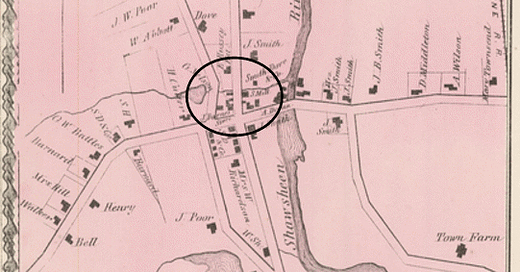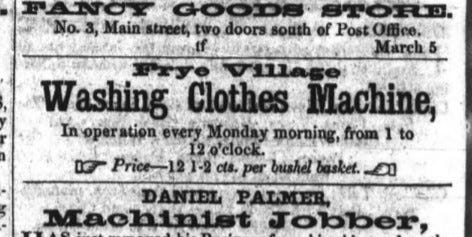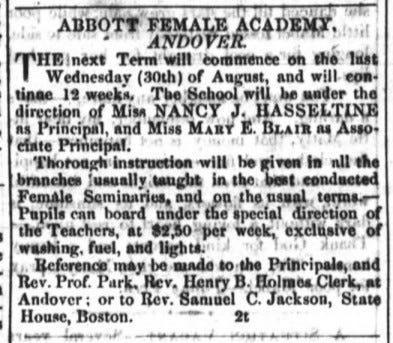Frye Village Stories: Hussey's Steam Laundry and the laundry stocks (pt1)
A Shawsheen Village 100 Story
Before Shawsheen Village Frye Village Stories: uncovering the story of “Andover’s famous laundry stocks”
The Frye Village Washing Clothes Machine was advertised in the first issue of the Andover Advertiser in 1853. It was in operation every Monday morning, from 1 to 12 o’clock. The price per bushel basket was 12 ½ cents.
The proprietor of the Washing Clothes Machine was not mentioned in the advertisement, nor did it appear in the paper after May 1853. The Washing Clothes Machine might have been Elijah Hussey’s first venture into the laundry business.
Detail of 1872 map of Andover and Frye Village
Miller Elijah Hussey had purchased two lots, water rights, and dam on the pond from the Frye in 1830. He operated a grist mill, sawmill, and machine shop. Elijah also bought the flowage rights for the dam to keep a pre-determined level of water in the pond between April and October to serve the mills downstream.
Elijah Hussey died in May 1869. In September 1869, his heirs were reported in the Andover Advertiser to be preparing to construct a building for laundry purposes. It was “to be located just east of their saw mill in Frye Village.”
A few months later, in January 1870, the newspaper reported that
“W. D. & C.G. (Charles G.) Hussey have leased the Mills in Frye Village (for)...new and improved stocks for washing clothes, carpets, etc.” In 1874, Charles G. Hussey took over the saw mill and “clothes washing concern.”
The 1885 Andover Directory includes this advertisement for Hussey’s Andover Steam Laundry.
“All kinds of family washing done in the best manner and at reasonable rates. Goods called for and delivered. Also logs sawed into lumber of any dimensions.”
The laundry continued in the Hussey family into the 1890s, even after the family had relocated to Chestnut Street.
Laundry
Who did washing, when, how, and for how much appears frequently throughout primary source documents. Apprenticeships typically included a specific amount of clothing, board, and washing that would not be provided.
This advertisement for Abbot Academy let potential students know that their washing was not included in their room and board.
The 19th century was a time of rapid change in work and home life.
The move from home to factory work created an increased need for laundry services outside the home. Furthermore, as work moved into office settings, the accepted standards of cleanliness changed. Think of the classic term “white collar worker.”
Women working outside the home in factories and offices could no longer spend days washing, drying, and ironing clothing. Hussey’s Steam Laundry advertised “all kinds of family washing done.”
According to one source “washing expenses incurred by laboring families were sometimes equal to half the sum they spent on rent.” Imagine what that dollar amount would be in today’s dollars!
Typically laundry workers were poor women and immigrants. In Andover street directories and newspapers women ran advertisements for hand laundry services operated in their home or business. In 1886, Sam Kee advertised his “Chinese Laundry” on Park Street, and in 1897 Wing Chin & Co operated a laundry at 17 Main Street.
Steam Laundries
A steam laundry was an industrial operation. Because it used steam to clean goods, such laundries required boilers, fuel, and other industrial equipment. They were very different from small hand laundry operations.
Industrial steam laundries advertised their services as being superior to services provided by “washerwomen” and immigrants. However, the flip side of that is that over time, small hand laundry operations, where a customer knew who was providing washing, came to be seen as superior to industrial operations. Hand laundry operations were the “boutique” laundry services of their day.
In July 1899, the Andover newspaper ran a story about Abel E. Grimes, who bought the Andover Hand Laundry from Mrs. M.A. Hodges. Grimes built a large laundry on Park Street. The article described the scale of a commercial laundry operation:
The laundry building is 75 feet long by 26 feet wide and 10 fee high. It is divided into three main rooms: the receiving and finishing room, the wash room, and the boiler and engine room. The receiving and finishing room, well lighted and ventilated, is finished in natural wood on the walls and has a hard wood floor.
In the front is the office where the work is taken and delivered. In this room are located the mangle for doing plain ironing, the combination shirt and collar machine – one of the best made – a band ironer, a collar shaper, a machine which will be used to iron shirt bodies and apparatus for doing hand worked. At the ear of this room are the drying rack, eight in number.
ACHC #1992.1437.1, this view of the inside of steam laundry was featured in an Andover Historical Society calendar
In this piece from September 1894, it also appears that Mr. Grimes’ Steam Laundry on Park Street had a connection with the Hussey Steam Laundry in Frye Village.
“The Andover and Lawrence Express, in connection with its regular business, will on Sunday evenings make a trip to the stocks in Frye Village with washings and return them on Monday morning. The proprietor will be pleased to attend all orders left at the Park Street office. The first trip will be made next Sunday evening.”
And with this mention of “the stocks,” I’ll close this week’s email. Next Friday’s Frye Village Stories will dive into the local story of Andover’s “famous laundry stocks.” Have you heard the story?











